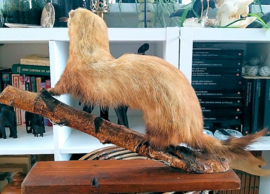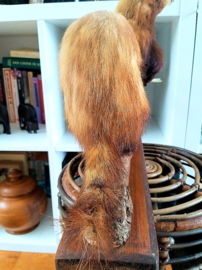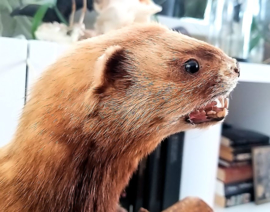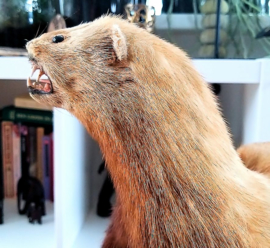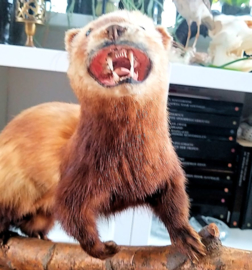Taxidermy: Beautiful large, male Polecat - Mustela putorius (standing mount)
Taxidermy: Beautiful large, male Polecat - Mustela putorius
- This Polecat died around 1950 of natural causes in Belgium. (non CITES)
- Standing mount. I suspect it at first was a haning mount (the branch) and that the added oak base is of a later date. Stands good and strong.
- Beautiful large male. Good, soft fur. Tail & claws are good. See all photos.
- Size: about 52x34x15 cm cm (length 52 cm - height 34 cm) - weigths 1080 grammes in total
- Will be shipped, securely packed, in a box. Europe only (please check your country's laws)
The European polecat (Mustela putorius) is a species of mustelid native to western Eurasia and north Morocco. It is of a generally dark brown colour, with a pale underbelly and a dark mask across the face. Occasionally, colour mutations, including albinos and erythrists, occur.] Compared to minks and other weasels – fellow members of the genus Mustela – the polecat has a shorter, more compact body; a more powerfully built skull and dentition; is less agile; and it is well known for having the characteristic ability to secrete a particularly foul-smelling liquid to mark its territory.
It is much less territorial than other mustelids, with animals of the same sex frequently sharing home ranges. Like other mustelids, the European polecat is polygamous, with pregnancy occurring after mating, with no induced ovulation. It usually gives birth in early summer to litters consisting of five to 10 kits, which become independent at the age of two to three months. The European polecat feeds on small rodents, birds, amphibians and reptiles. It occasionally cripples its prey by piercing its brain with its teeth and stores it, still living, in its burrow for future consumption
The European polecat originated in Western Europe during the Middle Pleistocene, with its closest living relatives being the steppe polecat, the black-footed ferret and the European mink. With the two former species, it can produce fertile offspring, though hybrids between it and the latter species tend to be sterile, and are distinguished from their parent species by their larger size and more valuable pelts.
The European polecat is the sole ancestor of the ferret, which was domesticated more than 2,000 years ago for the purpose of hunting vermin. The species has otherwise been historically viewed negatively by humans. In the British Isles especially, the polecat was persecuted by gamekeepers, and became synonymous with promiscuity in early English literature. During modern times, the polecat is still scantly represented in popular culture when compared to other rare British mammals, and misunderstandings of its behaviour still persist in some rural areas. As of 2008, it is classed by the IUCN as Least Concern due to its wide range and large numbers.





